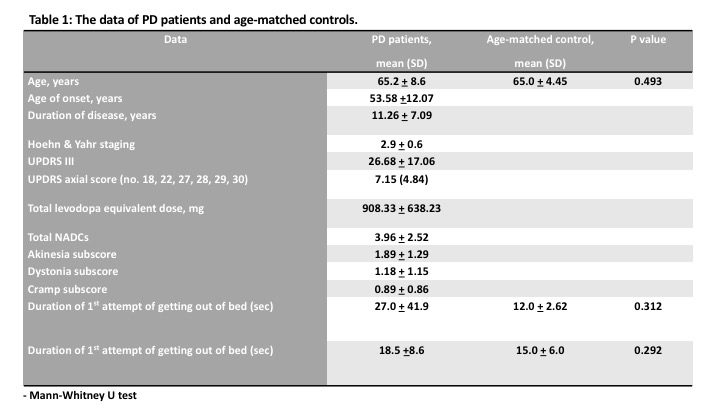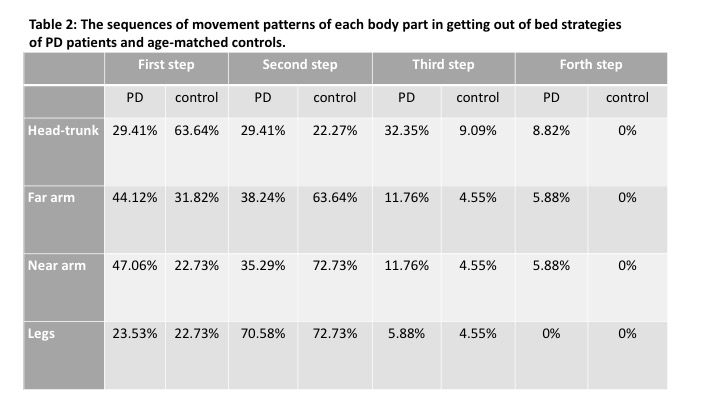Session Information
Date: Sunday, October 7, 2018
Session Title: Phenomenology and Clinical Assessment Of Movement Disorders
Session Time: 1:45pm-3:15pm
Location: Hall 3FG
Objective: To classify PD patients’ getting out of bed strategies using multisite wearable sensors.
Background: Getting out of bed represents a major challenge for Parkinson’s disease patients who experience early morning akinesia. To the best of our knowledge, there was no prior study that objectively evaluate getting out of bed strategies in PD patients(1,2).
Methods: PD patients were fitted with wearable sensors (NIGHT-Recorder) on their trunk, bilateral wrist and ankle and performed two attempts of getting out of bed (3,4). The triaxial accelerometer data was analyzed to determine the strategies employed. Getting out of bed movements were classified into: 1) head and trunk, 2) far upper limb, 3) near upper limb, and 4) lower limbs, with time taken to transfer from horizontal position to standing also measured.
Results: 19 PD patients (8 M, 7 F; mean age 65.2 + 8.6 years; HY stage 2.9 + 0.6) and 11 age-matched controls were included. The majority of patients (90%) could get out of bed independently, but their strategies differed from healthy adults. Common strategies employed by PD patients were using their arm: near arm (47.06%), far arm (44.12%), head/trunk (29.41%) and lower limbs (23.53%) to initiate getting out of bed. Common strategies to initiate getting out of bed in age-matched control were head/trunk (63.64%), far arm (31.82%), near arm and lower limbs (22.73%). PD patients used more time than controls to get out of bed to stand. We found significant correlation between the duration of the getting out of bed movement and the severity of UPDRS axial score (r=0.507, p-value= 0.045) in PD patients.
Conclusions: Our study represents the first objective evidence to demonstrate that PD patients employ different strategies for getting out of bed when compared to age-matched control. This information should be further studied with larger number of patients to identify appropriate strategies that is safe and provide the basis for rehabilitation.
References: 1. Mount J, Kresge L, LKlaus G, L M. Movement pattern used by the elderly when getting out of bed. Phys Occup Ther Geriatr. 2006;24(3):27- 43. 2. Mount J, Cianci H, Weiman R, Costa JD, Tabibian H, P J. How People with Parkinson’s Disease Get Out of Bed. Phys Occup Ther Geriatr. 2009;27(5):333-59. 3. Sringean J, Taechalertpaisarn P, Thanawattano C, Bhidayasiri R. How well do Parkinson’s disease patients turn in bed? Quantitative analysis of nocturnal hypokinesia using multisite wearable inertial sensors. Parkinsonism Relat Disod. 2016; 23:10-6. 4. Bhidayasiri R, Sringean J, Thanawattano C. Sensor-based evaluation and treatment of nocturnal hypokinesia in Parkinson’s disease: An evidence-based review. Parkinsonism Relat Disod. 2016; 22 suppl1:s127-33.
To cite this abstract in AMA style:
J. Sringean, C. Anan, C. Thanawattano, R. Bhidayasiri. What strategies do Parkinson’s disease patients use for getting out of bed? Preliminary results from multisite wearable sensors analysis [abstract]. Mov Disord. 2018; 33 (suppl 2). https://www.mdsabstracts.org/abstract/what-strategies-do-parkinsons-disease-patients-use-for-getting-out-of-bed-preliminary-results-from-multisite-wearable-sensors-analysis/. Accessed December 22, 2025.« Back to 2018 International Congress
MDS Abstracts - https://www.mdsabstracts.org/abstract/what-strategies-do-parkinsons-disease-patients-use-for-getting-out-of-bed-preliminary-results-from-multisite-wearable-sensors-analysis/


